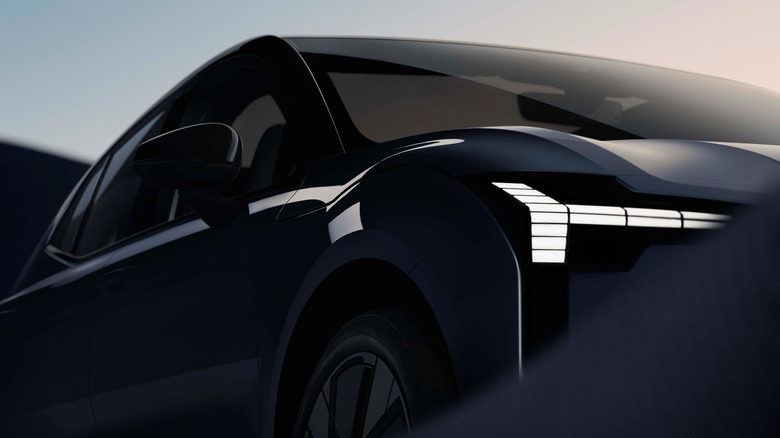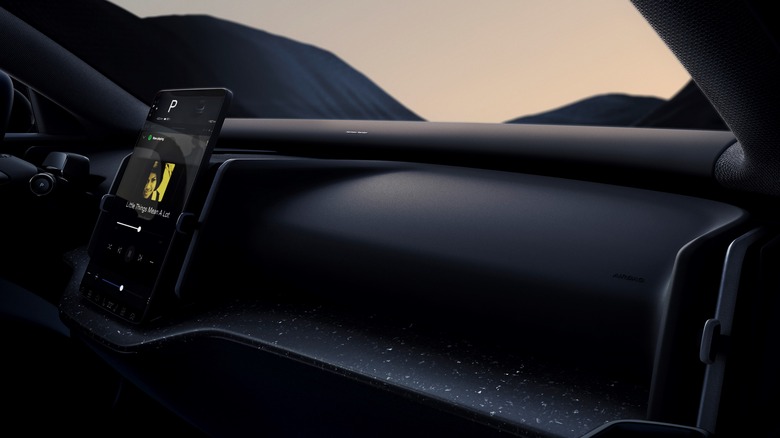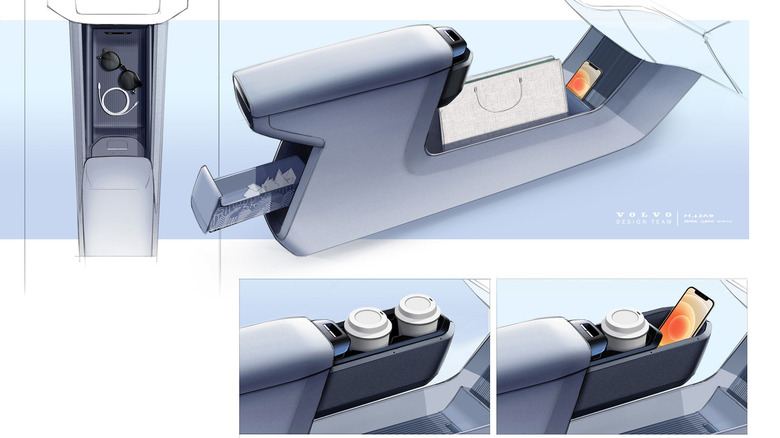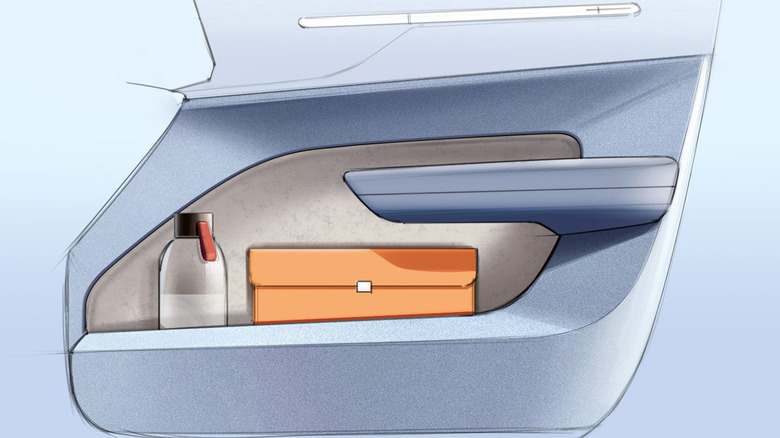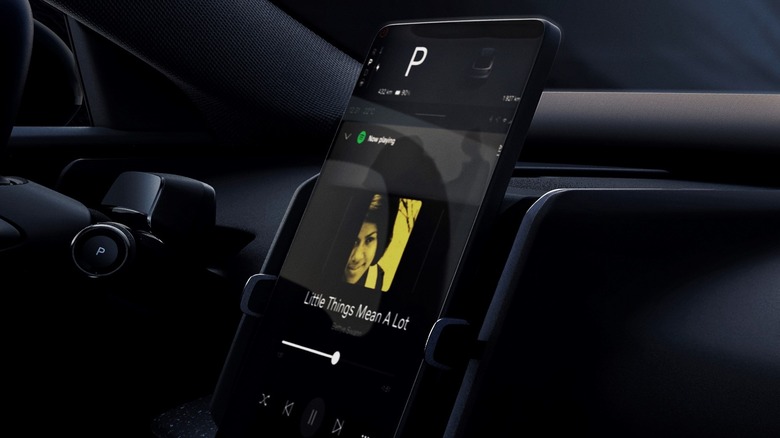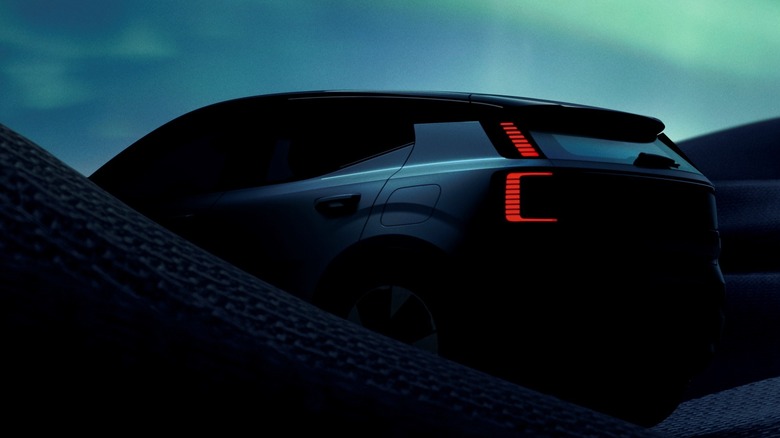How The Volvo EX30 Interior Will Change The Way You See EV Crossovers
The new Volvo EX30 may be a compact EV, but the automaker's expectations from it are unusually big. Electrification has long been used as an excuse to rip up and rethink the traditional ways that cabins, dashboards, and infotainment are delivered, not to mention how environmental friendliness impacts materials and design. Still, the second in the EX family — after the EX90 luxury SUV — will do more than most in upending things there.
"This is a new car for us, it's our smallest car," Lisa Reeves, Head of Interior Design at Volvo, told SlashGear in an interview ahead of the EX30's official debut next month. "This could be our Volvo shot of espresso."
Like that punchy hit of caffeine, it's about trimming back as much as possible — in weight, materials, and cost — until you reach the essentials. Some of that is dependent on having an electric platform, rather than the engine and transmission tunnel an internal combustion crossover would need to accommodate. However, it's also about intentionally throwing out cabin mainstays such as leather, wood, and metal in favor of sustainable alternatives which neither ape them nor feel second-best compared to them.
Rethinking luxury, not pretending to be it
The EX30 will offer four interior designs, which Volvo calls "rooms": they'll be more distinct, the automaker promises, than the current color schemes most cars and SUVs come in. That includes a wool blend made of 70% recycled polyester, for example — something Volvo previewed in its Concept Recharge — or flax from linseed plants that would otherwise be a waste crop. "We take the fibers from that," Reeves says, "and we weave it into this fabric that we lay over the doors and the top of the instrument panel."
Elsewhere, there's dashboard trim that includes pellets from PET plastic bottles and other waste, as well as pieces that include denim threads that are left over from making fabric for jeans. Rather than trying to make a leather or wood alternative, "we're trying to use recycled materials and embrace those aesthetics," Reeves says. In a similar vein, those materials surround a more focused implementation of technology that builds on things like Android Automotive OS.
All in all, it's a high-tech cabin that some Volvo traditionalists might find jarring at first. "Our philosophy is to focus it on the individual," Thomas Stovicek, Head of UX at Volvo, explained to SlashGear, but the particular individual who might be interested in the EX30 could well be a younger, more EV-savvy driver. Volvo is also hoping it'll be the model to attract new customers to the brand; as Reeves says, "each of our models have different purposes in our portfolio."
Meeting in the middle
Some of Volvo's strategy involves simply taking out or rearranging parts that, until recently, have been normal for vehicle interiors. There's no glovebox under the front passenger side of the dashboard, for example: instead, the EX30 puts it in the center. That, the automaker argues, means it's equally accessible for both the driver and the passenger, and also avoids intrusion into the passenger's footwell.
"It led us to this theme of centralization," Reeves says, "where we really looked to cluster all the features down the center of the car, freeing up the space around the people."
Gone, too, are the speakers you'd usually expect to find in the EX30's front doors. "We moved the midrange and the tweeters from the doors up to the instrument panel," Reeves explains, Volvo borrowing audio strategies from the TV soundbar in many living rooms. That bounces audio off the windshield to fill the cabin, but also reduces complexity and wiring in the doors, and maximizes capacity there for items such as larger water bottles.
The electric window controls are also in the center console — cutting down on switchgear duplication — while the air vents have been reorganized so as to reduce the amount of ducting that needs to be snaked through the dashboard. Arguably the most obvious feature of the EX30's cabin, though, will be the central storage unit in-between the front seats.
Easier to access storage, easier to build EVs
"This is providing the really flexible use of new space on the electric platform," Reeves says, "and allowing the customer to choose how to use it." In the lower tunnel, there's a sizable bin scaled for bags, laptops, or purses. Underneath it, there are two lidded compartments for stashing away sunglasses, cables, and similar.
A soft-grip nook for the wireless phone charger holds the phone snugly upright. Or, a phone can be dropped into the slide-out drawer: that has an adjustable divider and lid so that it can be used to hold two drinks, one drink and offer a storage bin, or entirely as a storage spot. Another slide-out box at that rear "can be used as a rubbish bin," Reeves suggests, "or taken from the car to go and wash, and bring back." A pleasing detail is the moose graphic on the side of that box, only visible when it's pulled out.
The result is not only simpler to look at and use but to manufacture. "Within this theme of centralization we also have a strong focus on symmetry in this car," Reeves points out, "helping us again with the components and the materials, for example in the tools. So, for example, we need less handed tools."
One screen to do everything
That makes it easier for Volvo to produce left- and right-hand drive versions of the EX30, as does its streamlined driver interface. As in a Tesla Model 3, there's no dedicated gauge cluster for the driver: instead, the top portion of the EX30's central touchscreen is dedicated to key metrics like speed. It was a decision that proved controversial when Tesla did it, but Volvo believes it's the right strategy for its new EV.
The touchscreen, for example, is taller and sits higher in the dashboard, putting that key information in what the automaker says is a very glanceable spot. "We have customized it slightly," Stovicek explains, "so that the basic information like the speed and the gear shifter are shifted closer to the driver, and then the surround view that shows what the multiple sensors in the car are doing — and the driver assistance — are off to the right."
The result, Stovicek insists, is "a similar, if not easier to glance location" than a regular cluster like in the EX90. Enough, indeed, that while Volvo looked at the potential for a head-up display, the automaker decided the extra complexity wasn't necessary here.
A new look for Android Automotive OS
Instead, Volvo focused its efforts on its single touchscreen interface and a new iteration of its Android Automotive OS-based infotainment. "We're taking a lot of the learnings that we've had from our existing cars in the market, paired with the tech in the new cars," Stovicek says, "and we've given the system a bit of a refresh in terms of information architecture and display. There's new technology in here that's making it more responsive, better rendering times, so it's a richer, more interactive system."
As well as the persistent driver information along the top, the EX30's screen will include a fixed system bar at the bottom for climate and volume adjustment, and to jump to the home screen. There'll also be a contextual bar, its shortcuts evolving depending on what the individual driver accesses most often. "As we gather data about what customers are doing," Stovicek explains, "we'll be able to tweak that." The EX30 will also have an embedded 5G modem for pulling down over-the-air updates among other changes.
The bulk of the screen will use a newly-developed interface that revolves around four common contexts: Charging, "Welcome," Driving, and "Goodbye." The Charging view, for example, will include an oversized battery status display, readily visible from outside of the EV.
All about keeping your eyes on the road
While Volvo won't be hiding any information, it's nonetheless hoping that this quartet of displays will make it "more likely that the right information is there," Stovicek says. That should hopefully cut down on menu digging.
"The driving mode has things that people do the most: navigation, media, phone, climate," Stovicek says by way of example. "That's the starting point for your experience with the car when you're driving, so it's a good sort of anchor screen." Down the line, Volvo plans to tweak and customize those anchor screens, too, depending on how owners interact with them.
That said, the automaker is wary of doing anything which potentially messes too much with muscle-memory. Individual customizations will be linked to driver profiles, which can be automatically restored when phone-as-key is used to access the EX30. As for what the new EV brings to the party in terms of performance and range, for that we'll have to wait until the Volvo EX30's official unveiling on June 7, 2023.
